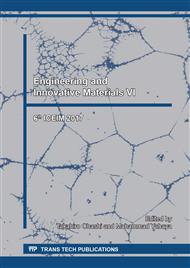p.297
p.302
p.307
p.312
p.318
p.325
p.332
p.337
p.342
Studies on Physical and Mechanical Properties by Soda-AQ Pulping of Napier Grass
Abstract:
Pulp and paper production from wood material as their main resources have a total capacity about more than one million tons per year. Malaysia has a high scale of deforestation based on the main resource for pulp and paper-based industry. Malaysia as its rate is accelerating faster than any other tropical countries in the world. This problem also affects the economic losses of some countries that face deforestation. To overcome this, Napier grass as a substitute material from non-wood material had been choose for pulp and papermaking industry. This study through the full fibre analysis and morphological characterization, pulpability at kappa number via soda-AQ pulping and the characteristic. These conclude that Napier grass had a high percentage of pulp yields; with a low screening rejects; good mechanical properties by TAPPI method. Thus, Napier grass has a potential to be substitute material for becoming waste-wealth product especially for Malaysia’s pulp and papermaking industry.
Info:
Periodical:
Pages:
318-321
Citation:
Online since:
January 2018
Keywords:
Price:
Сopyright:
© 2018 Trans Tech Publications Ltd. All Rights Reserved
Share:
Citation:


